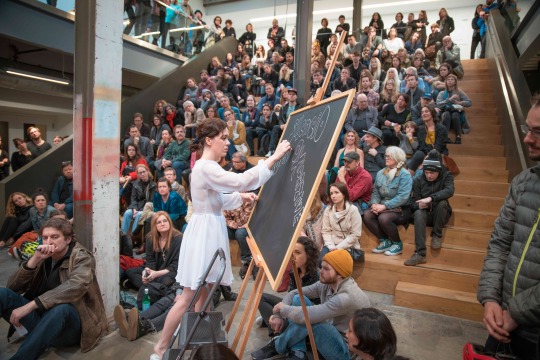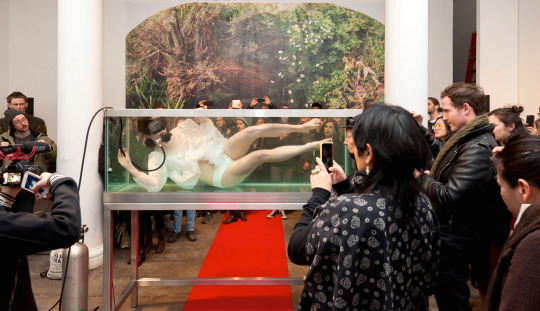Conversations | Nadja Verena Marcin’s OPHELIA World Tour
“Like underneath an hourglass, my approach is to be closer together, to acknowledge our singularity.” – Nadja Verena Marcin
German-born artist Nadja Verena Marcin pays homage to the Shakespearean noble figure, Ophelia, in her latest multidisciplinary work by the same name. With imagery alluding to John Everett Millais’s painting, Ophelia, OPHELIA is a live performance and video installation that re-imagines this character as an embodiment of our human subjectivity within the framework of gender inequality and climate change.
With previous performances at the Minnesota Street Project in San Francisco and Fridman Gallery in New York, OPHELIA is slated for viewings in Berlin, Rome, London, and Bolivia, among others. NYFA Fiscal Sponsorship had the chance to speak with Marcin as she embarked on the OPHELIA world tour.
NYFA: Your performance and installation were inspired by a visit to the TATE Britain where you encountered John Everett Millais’s painting, Ophelia. What drew you most to his work?
Nadja Verena Marcin: A couple years ago, on a layover in London, I went to the TATE Britain. Strolling through the masterpieces, I didn’t expect anything, but there was one painting, like a ghost emerging from the past, that truly spoke to me: Ophelia by Millais, 1851-2.
What triggered me about Ophelia was the parallel between trauma, silencing, emotions, instincts, nature, femininity, and loss—the psychological interiority of the image. I have a preference for dramatic gestures seen with a wink of an eye, and it felt like Ophelia was the 19th century Pietà, where nature was the mother and the human was the child. Her character became a poster child of hysteria, e.g. women accused of being an Ophelia by doctors in the 19th century, leading millions to create new depictions of Ophelia until now.
NYFA: In addition to Millais’s painting, what other works of art does OPHELIA reference? How do those references create new layers of meaning in your work?
NVM: OPHELIA also references The Werld by Daniil Kharms and Three Ball Total Equilibrium Tank by Jeff Koons.
Kharms’s text speaks to the desire to see the world and the drive to understand it, while unable to fully grasp it. His text is spoken underwater, becoming distorted sounds and water bubbles that hit the surface, and is recorded and amplified throughout the space.
In Three Balls Equilibrium Tank, the world renders its existence in our memory—the basketballs are like segments of time and divested of weight—are lifted into a dream-like atmosphere. Jeff Koons’ work refers to Duchamp’s idea of the ready-made and how our subjective interpretation creates new meanings. OPHELIA wants the audience to re-think and undergo an experience that shatters predictions and opens their eyes and hearts to our vulnerability and fragile nature.

NYFA: Your project alludes to subject matter like climate change, gender inequalities, and memes which all tie back to our limitations of our subjective experience. Do you believe we are bound to our subjective experience? Can we only learn from the past?
NVM: A subjective experience happens in the present. The past is based on memories filtered through the curatorial decisions of our mind informed by our education, emotions, and will. The present also includes these decisions, but we cannot make these decisions as precisely and quickly because we are simply human. In a real life experience we cannot control all factors, and many influences are unforeseeable.
To me, we only learn from the present. That is why the live performance part of OPHELIA is the most significant part—it is an event where 200-300 (or more) participants come together and dive into a tank of variables. It is a blind date. You exist without a clear goal. Regarding the themes of climate change, gender inequalities, and memes, the best thing is to understand the freedom of choice and that each of us individually matters. Question existing structures and creatively rethink how to design your life and our future. Everyone has the power to do this.
NYFA: So far on the OPHELIA tour, the work has been shown at spaces such as the Fridman Gallery in New York and the Minnesota Street Project in San Francisco. Before presenting a live performance of the piece, were there certain rituals you took to prepare yourself to inhabit the role of Ophelia?
NVM: Each time I perform OPHELIA, I feel this unity and peace that comes from somewhere—it comes from the universe. This peace follows me into the space and settles between all of us. In the beginning, there is also a longer ritual where I pass through the audience and acknowledge everyone individually. Without words, I say: “you are here, and I am here, and we are here; it is now time and nothing else.” Like underneath an hourglass, my approach is to be closer together, to acknowledge our singularity.

NYFA: How have audiences responded to your own presentation and interpretation of Ophelia?
NVM: As a participant, it takes me a longer time to understand what happened at each performance. I become an Other and feel an energy spark through everyone present and through our eternity. In both San Francisco and New York, many people came to thank me and expressed how much this performance meant to them. Many congratulated me, saying it was the best performance they had seen in a long time. At times, people looked at me with doubt in their eyes, and I can tell they are wondering: “Who am I?” as Andre Breton said in the first sentence in Nadja.
NYFA: What cities and countries does OPHELIA travel to next on its world tour?
NVM: Following the San Francisco presentation, OPHELIA will travel to Moltekerei e.V., a historical 70’s space for performance and sound art as part of the DC Open Gallery Weekend in Cologne, Germany; and Nube Gallery in Santa Cruz, Bolivia. Towards the end of the year and the beginning of next year, OPHELIA will also head to AlbumArte in Rome, a historical space for women’s art; SCHAUWERK in Sindelfingen, Germany; the Art Pavilion in London, United Kingdom for a one week festival on eco-feminism; and Berlin, Germany.
NYFA: Why did you choose NYFA Fiscal Sponsorship?
NVM: NYFA has a long-term commitment to the arts in New York. Coming from Europe, I love how NYFA has witnessed time and stood in the midst of things. NYFA’s staff sees the complexity of the art scene, welcoming artists from all over the world. NYFA is a true New York treasure—their staff are generous, caring, profound, and consistent. I love sharing a part of this voyage of mine with NYFA.
– Interview conducted by Priscilla Son, Program Associate, Fiscal Sponsorship & Finance
Are you an artist or new organization, and interested in increasing your fundraising opportunities through NYFA Fiscal Sponsorship? We accept Out-of-Cycle Reviews year-round. No-fee applications are accepted on a quarterly basis and the next deadline to apply is June 30. Click here to learn more about the program and to apply. Sign up for our free bi-weekly newsletter, NYFA News, for the latest updates and news about Sponsored Projects and Emerging Organizations.
Images: (1 and 2) OPHELIA at Minnesota Street Project, San Francisco, 2018, Photo Credit: Thomas Sparks; and (3) OPHELIA at Fridman Gallery, New York, 2018, Photo Credit: Chris Waggone. All images courtesy of Nadja Verena Marcin and 532 Gallery Thomas Jaeckel, New York, and AkArt, San Francisco. © Nadja Verena Marcin
Video: OPHELIA, Minnesota Street Project, San Francisco, 2018, Photo Credit: Thomas Sparks. All images courtesy of Nadja Verena Marcin & 532 Gallery Thomas Jaeckel, New York, & AKArt, San Francisco. © Nadja Verena Marcin





